“Regardless of whether the examiner is entry-level or a GS14 seasoned primary examiner, the 2021PAP lowers the bar they must meet in determining compliance with Sections 102, 103 and 112 from Advanced to that of a Basic activity.”
 The U.S. Senate Committee on the Judiciary’s Subcommittee on Intellectual Property recently held hearings on the topic of Protecting Real Innovations by Improving Patent Quality. The Subcommittee is to be commended for seeking practical solutions to improve patent quality. To this end, the author respectfully recommends that the Subcommittee and the intellectual property (IP) community take a close look at the United States Patent and Trademark Office (USPTO)’s revised Performance and Appraisal Plan (PAP) for patent examiners.
The U.S. Senate Committee on the Judiciary’s Subcommittee on Intellectual Property recently held hearings on the topic of Protecting Real Innovations by Improving Patent Quality. The Subcommittee is to be commended for seeking practical solutions to improve patent quality. To this end, the author respectfully recommends that the Subcommittee and the intellectual property (IP) community take a close look at the United States Patent and Trademark Office (USPTO)’s revised Performance and Appraisal Plan (PAP) for patent examiners.
Revised PAP Portrayed as a Roadmap to Improve Patent Quality
In 2019, then IP Subcommittee Chairman Senator Tillis held hearings entitled Promoting the Useful Arts: How can Congress prevent issuance of poor quality patents? In his testimony, witness Drew Hirshfeld, then-Commissioner for Patents, now performing the functions and duties of the Under Secretary of Commerce for Intellectual Property and Director of the USPTO, announced “beginning next fiscal year, there will be a new performance evaluation that will serve as a roadmap to improve patent quality” (page 5). In his questions for the record, Senator Chris Coons (D-DE) requested the revised PAP. Six months later, the USPTO inserted the revised 2021PAP, “which the USPTO plans to implement in FY2021” (between pages 11-12 of their Response).
So What’s Changed?
This article compares the quality element of the 2021PAP with prior versions to identify changes affecting patent examination quality. Copies of PAPs, current or prior, are not readily available on USPTO and Patent Office Professional Association (POPA) websites. The 2010PAP quality element was archived from the PAP Guidelines, formerly made publicly available by POPA (April 19, 2012). The 2014PAP is found in the Statement of Robert D. Budens before the House Committee on the Judiciary and the House Committee on Oversight and Government Reform (November 18, 2014). The 2015PAP quality element was published by National Academy of Public Administration (NAPA), in their Telework Internal Control and Program Review. Pages 112-113 of the NAPA Report.
The USPTO relies upon criteria set forth in the PAP to rate the examiner’s annual performance into one of five categories: Outstanding, Commendable, Fully Successful, Marginal or Unacceptable. The 2021PAP contains at least five changes that would permit examiners to receive higher ratings while performing lower quality work. These five changes will likely reduce the quality of the examiners’ work products—rejections and allowances—while increasing the number of examiners eligible for Commendable or Outstanding ratings.
First, the weight given to the quality element is reduced from 35% of the overall rating in the prior PAPs to 30% in the 2021PAP. This reduction will likely incentivize examiners to devote less time and attention to their work quality than they did under the 2010PAP and 2015PAPs.

Second, the 2021PAP permits examiners to make significantly more quality errors while still earning top ratings. Under the prior PAPs, an error rate higher than 4.49% would have prevented an examiner from obtaining a Commendable or Outstanding rating. Now, the 2021PAP permits examiners with an error rate as high as 6.49% to qualify for an Outstanding rating

Third, the 2021PAP lowers the standards for evaluating whether an examiner properly complies with 35 U.S.C. Sections 102, 103 and 112.
The Office of Personnel Management (OPM) Position Classification Standard sorts patent examiners’ functions into three levels of activity:
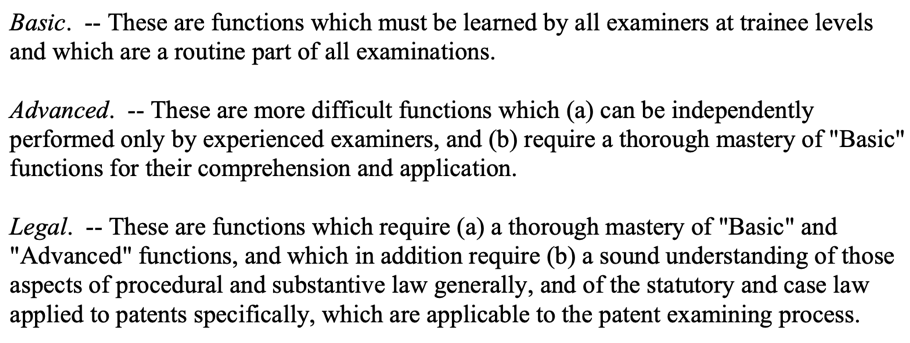
The 2021PAP lists 19 functions, renamed by the USPTO as Quality Major Activities (QMAs)), required for the examination of patents. In the second column of Table 3, the USPTO has assigned an activity level for each QMA, resulting in six Basic QMAs, four Advanced QMAs and nine Legal QMAs.
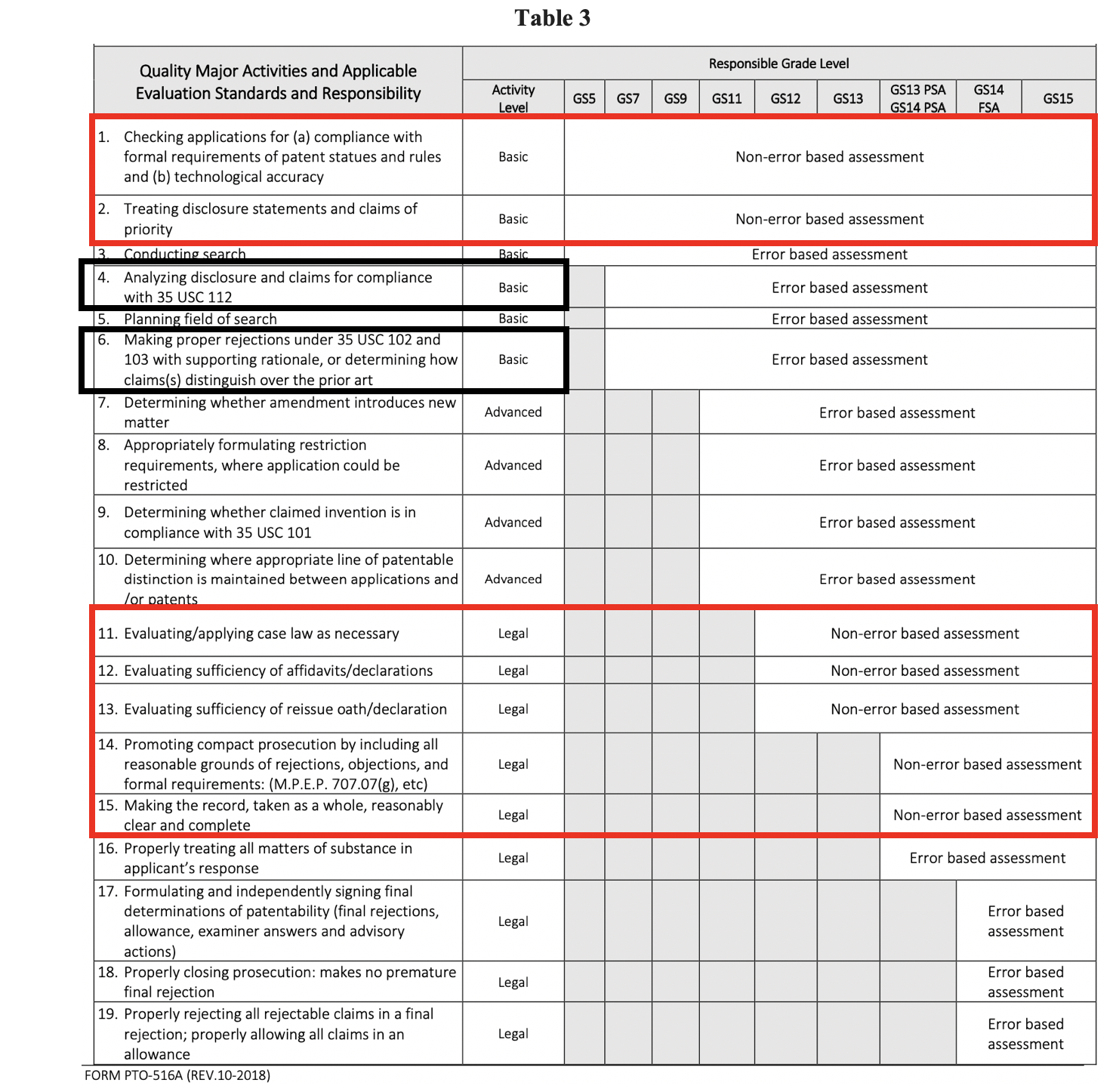
In Table 3, black boxes outline two QMAs now downgraded from the 2015PAP’s Advanced level to Basic level:
(4) Analyzing disclosure and claims for compliance under 35 U.S.C. Section 112 and
(6) Making proper rejections under 35 U.S.C. Sections 102 and 103 with supporting rationale, or determining how claim(s) distinguish over the prior art.
Determining whether the specification contains a brief description of each drawing is an example of a Basic activity that can be performed with little more than cursory review. Basic activities do not require the examiner to apply “a sound understanding of the procedural and substantive law generally, and of the statutory and case law to patents specifically, which are applicable to the patent examining process.”
Regardless of whether the examiner is entry-level or a GS14 seasoned primary examiner, the 2021PAP lowers the bar they must meet in determining compliance with Sections 102, 103 and 112 from Advanced to that of a Basic activity. See Excerpt from 2021PAP Quality Table 1:
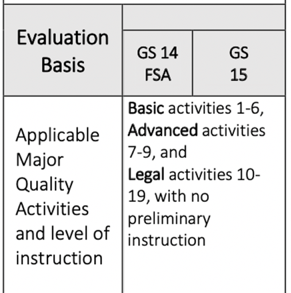
In contrast, the 2015PAP evaluated the examiners’ analysis for compliance with Sections 102, 103 and 112 in terms of the more difficult, Advanced activity.
From 2015-2021, no change to patent statutes or MPEP guidance occurred which would have simplified an examiner’s analysis for compliance with Sections 102, 103 and 112. Downgrading the activity level of QMAs (4) and (6) from Advanced to Basic will likely incentivize examiners to spend less time, effort, and analysis when reviewing applications for compliance with Sections 102, 103 and 112.
If Congress and the IP community seek to improve the USPTO’s compliance with Section 112, they may wish to consider discussions with the USPTO to reinstate the Advanced level for compliance with Section 112 or even increasing the standard to the Legal level.
Fourth, the 2021PAP invents a new non-error-based assessment evaluation standard shown in Table 3, red boxes, and applies this mulligan to seven of the nineteen (37%) QMAs as listed in Table 4.
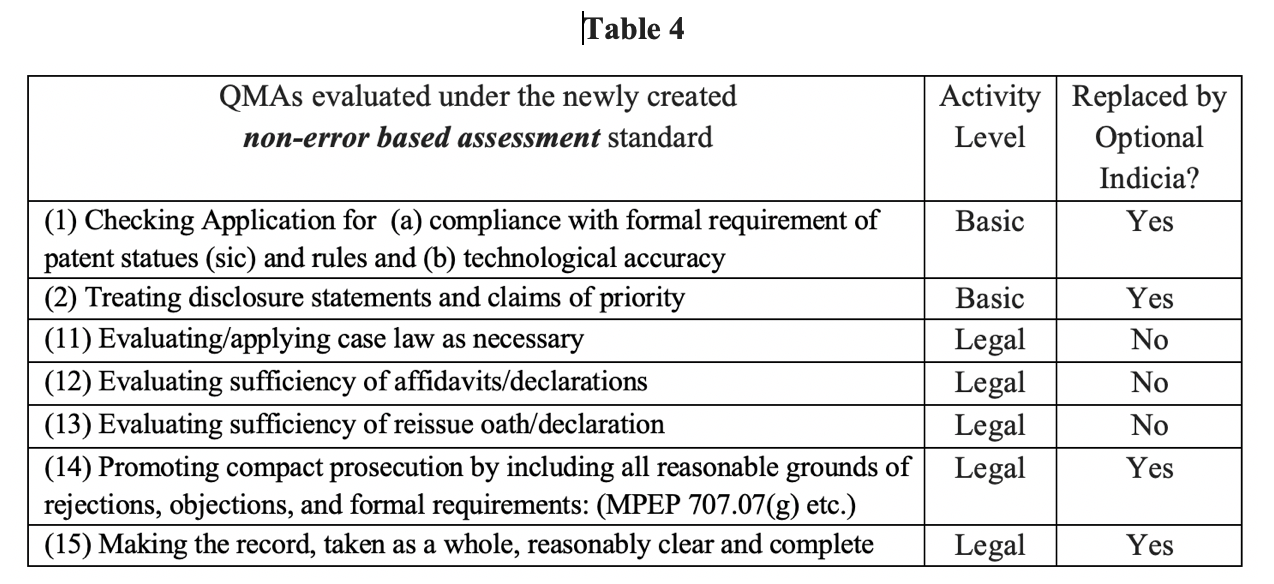
Errors made in QMAs (1)-(2) and (11)-(15) are seemingly excluded from the newly expanded 6.49% error rate threshold. Correctly performing QMAs evaluated under the non-error- based assessment standard is apparently left up to the examiner’s discretion. Some QMAs now evaluated under the non-error-based assessment standard are replaced by optional indicia. Others are not. Apparently, the 2021PAP does not require examiners to correctly evaluate/apply case law as necessary (QMA (11)) or evaluate the sufficiency of affidavits/declarations (QMA (12)). Examiners who fail to correctly perform any of the QMAs listed in Table 4 may still be rated as Fully Successful.
Omitting 37% of the MQAs from the USPTO’s overall quality statistics will create the impression that patent quality is higher than it actually is. What if 37% of the critically important car components were optionally or haphazardly installed by autoworkers, without risk of running afoul of quality control?
This new evaluation standard appears in conflict with OPM’s Position Classification Standard, which governs the USPTO and which does not identify any assigned patent examination activities for which correct performance is optional or unreviewable.
Fifth, the 2021PAP expands indicia under which examiners may obtain higher level ratings. The use of indicia to justify higher ratings (Outstanding or Commendable) is not new. The 2010PAP provides the following Indicia 1-3, with which examiners must fully comply in order to receive higher ratings.

To earn a Commendable rating under the 2010PAP, examiners must comply with all three indicia in substantially all actions. Examiners failing to meet all three indicia were to be rated one level lower—Fully Successful—even if they met the 5.49% error rate required for a Commendable rating. See 2012PAP Guidelines.
In contrast, to earn a Commendable rating under the 2021PAP, the examiner must only comply with the three indicia in the majority of all actions, i.e., 51% of their applications. In their other applications, the examiner can fail to comply with Indicia 1-3 and still be rated Commendable. It appears the 2021 PAP allows commendable-rated examiners to select applications to which the more lenient criteria would be applied.
Further, the 2021PAP permits examiners to pick-and-choose between open-ended lists of sub-indicia for activities to apply in their Office actions and allowances.
“The examiner may demonstrate compliance with this indicia when office actions, or prosecution histories taken as a whole, include some or all of the exemplary activities listed below, as appropriate, or any additional activities or characteristics not listed below.” Emphasis added.
Indicia 1, Search and Prior Art, lists 4 optional activities:

Indicia 2, Clarity of the Record, lists 8 optional activities:

Indicia 3, Compact Prosecution, lists 9 optional activities:

An examiner who fails to perform all these activities can still be rated Fully Successful, defined as “good sound performance” in the 2014 PAP.
The newly touted indicia make it easier for an examiner to obtain a Commendable or Outstanding rating. Some indicia are redundant. An examiner can demonstrate simultaneous compliance Indicia 1 and 3 by choosing to:
Search the inventive concept as defined at the time of the first office action on the merits (Indicia 1(a)) and
Perform a thorough search for the claimed invention as defined in the application at the time of the first office action. (Indicia 3(i)).
Some indicia impose burdens on applicants. To demonstrate compliance with Indicia 3, examiners may “make a complete restriction/election of species requirement” in every application. Indica 3(f).
To demonstrate compliance with Indicia 2, examiners may include, whether warranted or not, “their interpretation on the record of claim language that is functional, expresses use/result, or is non-functional descriptive material, or means for language.” Note such “documenting may include but is not limited to the interpretation of claims under 112(f) using the appropriate form paragraph.” Indicia 2(b).
Extraneous 112(f)-like statements in Office actions and Notice of Allowances may create the appearance that examiners are focusing more on Section 112(f) analysis. However, the bar for evaluating examination for compliance with Section 112 has been reduced to the Basic level, so cursory review suffices. No sound understanding of Section 112 and its related caselaw is required by the 2021PAP.
Déjà vu All Over Again?
This is not the first time the USPTO has travelled down this road. In 2015, the Department of Commerce Office of Inspector General (OIG) determined in their Final Report entitled USPTO Needs to Strengthen Patent Quality Assurance Practices, that the “USPTO’s official quality metrics may underrepresent the true error rate.” OIG-15-026A
OIG found that “over 95 percent of all patent examiners received outstanding or commendable ratings for the quality element of their annual performance evaluations (see Figure 2) even though the Department defines Commendable performance as ‘unusually good’ and Outstanding performance as ‘rare, high quality performance’ that ‘rarely leaves room for improvement.’” The distribution of scores does not align with the ratings descriptions contained in the Commerce Department’s guidelines for performance appraisals.” OIG-15-026A pages 5-6.

Even PAP Appendix A defines Outstanding as “rare high-quality performance” and Commendable as “unusually good performance.” 2014 PAP.
The OIG found that, between FY2009 and FY2013, higher rated examiners earned on average $6,000 in annual bonus awards. Page 4.
The OIG’s concerns from 2015 seem relevant today:
The weaknesses we identified with the current performance plan make it difficult to distinguish between patent examiners who are issuing high-quality patents and those who are not. In July 2014, the Deputy Director of the USPTO stated that “issuing high-quality patents not only improves the overall vitality of our patent system but can also play a significant role in curtailing abusive patent litigation.” We are concerned with USPTO’s inability to distinguish and reward examiners performing at a truly Outstanding level of performance versus those who are not. OIG-15-026A page 9.
2021PAP’s Roadmap to Quality leads to Lake Wobegon
Note the USPTO portrays the revised plan as “a valuable tool to assist in performance improvements” intended to “foster the Outstanding work that the vast majority of the examiners already do.” Response. The USPTO’s goal is seemingly to increase the quality ratings for patent examiners, not to increase patent examining quality itself. The 2021PAP significantly erodes five aspects of the quality element.
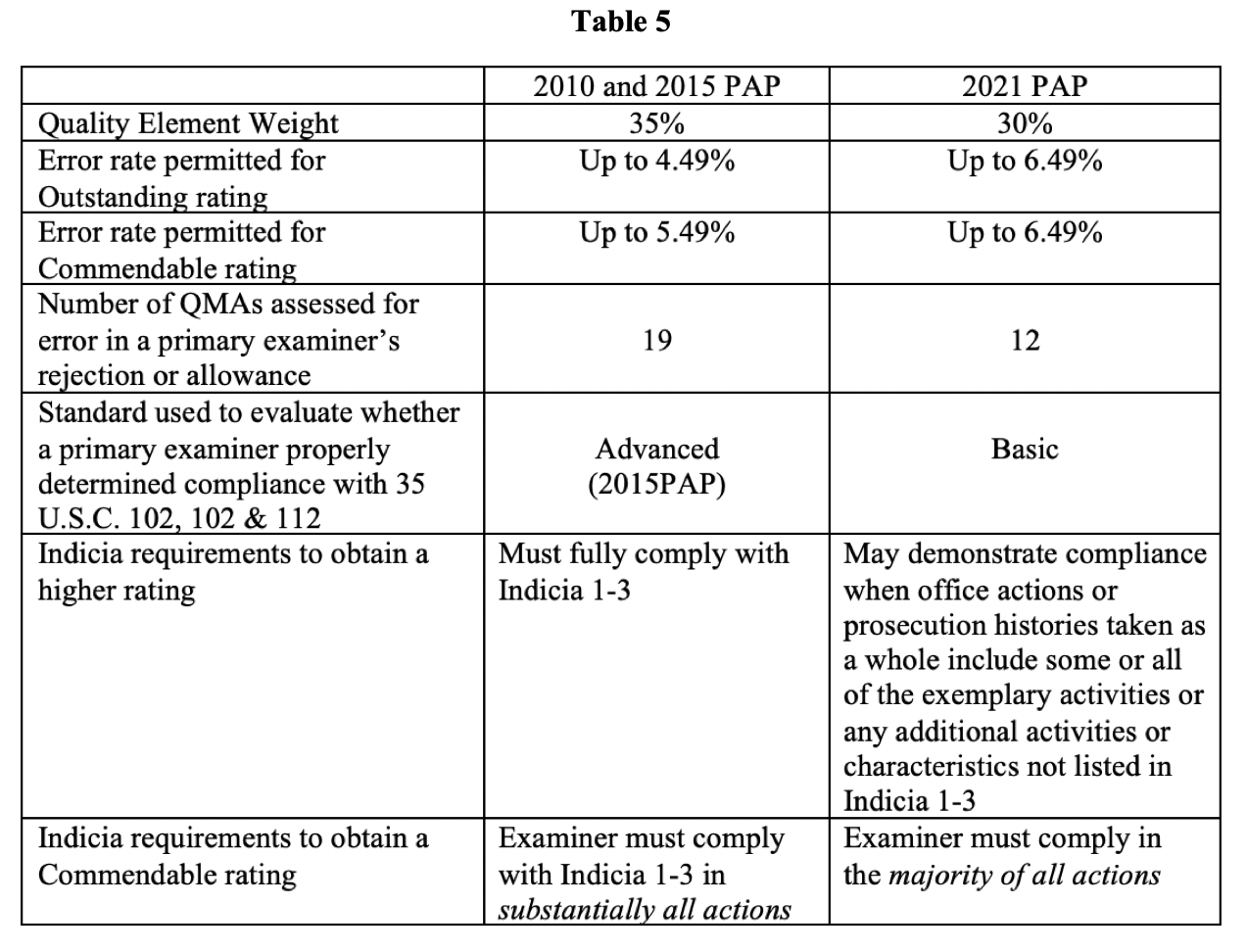
These revisions will likely result in examiners obtaining higher ratings without actually performing higher quality work. As such, the 2021PAP’s Roadmap to Quality leads directly to Lake Wobegon—that happy place where all examiners are rated above average.
IPWatchdog reached out to the USPTO for comment on this article, but we had not received a response as of the time of publication.
Image Source: Deposit Photos
Image ID:7453448
Copyright:kelpfish

![[IPWatchdog Logo]](https://ipwatchdog.com/wp-content/themes/IPWatchdog%20-%202023/assets/images/temp/logo-small@2x.png)

![[[Advertisement]]](https://ipwatchdog.com/wp-content/uploads/2023/01/2021-Patent-Practice-on-Demand-1.png)
![[Advertisement]](https://ipwatchdog.com/wp-content/uploads/2024/04/Artificial-Intelligence-2024-REPLAY-sidebar-700x500-corrected.jpg)
![[Advertisement]](https://ipwatchdog.com/wp-content/uploads/2024/04/UnitedLex-May-2-2024-sidebar-700x500-1.jpg)
![[Advertisement]](https://ipwatchdog.com/wp-content/uploads/2024/04/Patent-Litigation-Masters-2024-sidebar-700x500-1.jpg)

![[Advertisement]](https://ipwatchdog.com/wp-content/uploads/2021/12/WEBINAR-336-x-280-px.png)
![[Advertisement]](https://ipwatchdog.com/wp-content/uploads/2021/12/2021-Patent-Practice-on-Demand-recorded-Feb-2021-336-x-280.jpg)
![[Advertisement]](https://ipwatchdog.com/wp-content/uploads/2021/12/Ad-4-The-Invent-Patent-System™.png)






Join the Discussion
35 comments so far.
ipguy
July 6, 2021 08:32 pm@33 “the tricks examiners use to generate RCE’s”
Such as improper Second Action Finals?
In regards to a second action being declared final due to amendment by the applicant that (supposedly) required additional searching, in the old days, the MPEP used to flat out state (I forget the exact language) that a second action final was improper if the claim was amended to include a feature that the examiner should have reasonably expected the applicant to claim, and should have already searched for that feature.
Personally, I have come to believe that a directive from PTO management came down in the last 20 years or so that the MPEP should have any applicant-friendly language expunged.
Again, I don’t blame examiners for the actions of PTO Management.
Anon
July 6, 2021 06:29 pmipguy,
Any such arrangement is a known and recognized item (under Freedom to Contract).
There is no such thing between an applicant that pays a fee for a fully legitimate patent — one when remembers the point that I have presented in that the “time allotted” aspect is an internal metric and NOT an agreement between applicant and the US Patent Office.
AAA JJ
July 6, 2021 04:08 pmExaminers have a limited time to examine each application. No amount of petulant, cry baby whining is going to change that. Understanding the tricks examiners use to generate RCE’s and cutting them off at the pass is the key to getting the best result for clients. Nothing motivates examiners to do the job correctly more than being forced to work for no counts. The instant the examiner is aware that their game playing shenanigans is not going to result in an RCE is when the examiner gets serious about finding a way to allow the application rather then reject it.
ipguy
July 6, 2021 02:59 pm@30 “I personally try to do the best job that I can on each Application in the time that I am allotted”
The same can be said for many patent attorneys and agents who work on a fixed fee basis for responding to Office Actions or draft applications at a capped amount set by the client. Of course, it’s one thing if you’re on a salary and another thing if you’re working on a commission basis.
Anon
July 6, 2021 12:43 pmPrimary Examiner,
You had me until the ‘time allotted’ aspect. As I stated, that is an internal metric and not a part of the law (to which you ARE charged to ethically examine under).
As I have long posted, IF you cannot do the proper job merely because of time, you (the Royal You, as in ALL of You) need to engage your union and force the issue to have proper time allotments.
The notion of ‘good enough for the amount of time‘ is a disservice to the Office and to my clients.
Primary Examiner
July 6, 2021 09:50 am@26
I’ve seen poor Examiners (like you said, everybody knows who they are), and poor SPEs as well – ones that sign off on bad quality work.
I’ve seen poorly written/poor Applications as well. Luckily for me, most of the Applicant’s representatives that I work with are ethical and willing to work with me, to advance the Application with the Applicant’s best interest in mind. In fact, I find only about 5% of representatives that I interact with to be unethical, aggressive (without justification), and adversarial just for the sake of being so. If the percentage would be much higher, I would change professions.
I personally try to do the best job that I can on each Application in the time that I am allotted – if the expectation would be that I would have to spend much more time than the weekly 40 hrs that I am paid for and expected to work (more than 50 hrs a week let’s say), I would personally change professions in that scenario as well.
You’ve provided some great suggestions in regards to Quality, and on how it could be improved. I’m sure the Office has thought of these implementations as well.
The Office has to balance Quality, Production and DM. In my opinion, what makes the wheel turn at the moment is definitely Production and DM. Until Quality takes priority over the other 2, I don’t see the Office implementing any further steps (including the ones that you mention) that would surely improve patent/examination Quality.
AAA JJ
July 6, 2021 08:39 am“One day, should you ever leave the Office,…”
At a previous firm, was interviewing an examiner for an associate position. One of my partners asked, “How would you address a rejection based on In re Aller.” Response was, “You can’t overcome that.”
No offer was made.
AAA JJ
July 6, 2021 08:37 am“…why there are no ‘lessons learned’ following Board decisions (especially reversals).”
Quite simply because they don’t want to learn any lessons. Many examiners, SPE’s, QAS’s, OPQA hacks, and other useless, do nothing, know nothing, brain dead GS-15’s use the appeal process as a way of saying, “These claims are too broad!!!! I’m not allowing them!!!! Let the Board do it!!!!”
Dealt with an examiner for years on a lot of cases. Really good examiner. His art was always the closest. Wasn’t stretching the prior art. Too much. But would constantly combine two, or more, references, acknowledge a feature, or two, missing, but….see In re Best!!!!!
I would explain, over and over and over, In re Best is not applicable to the rejection. Get him reversed.
A month or two later, a new OA in a different case. 2+ reference combination. Doesn’t show feature X. But…see In re Best!!!!!
There are no negative consequences for that behavior. In fact, there are only positive consequences. “He’s doing record breaking quality outstanding work!!!!” Because he rejected the claims. When they get reversed, the attitude is, “Well, the Board doesn’t understand this art. They don’t know nothing. It was a clear difference of opinion. Perfect case for appeal.”
Lather. Rinse. Repeat.
ipguy
July 6, 2021 05:00 am@23
“outside of inherently determining it on a case by case basis”
I’ll also take a guess that no one at the Office ever trained you on how to demonstrate that each piece of prior art you are citing in the rejections reflects an appropriate level of skill in the art. In my opinion, the whole inherent determination thing is a complete sham. Examiners aren’t to blame. It’s just the way the Office has been operating for decades.
When I worked at the USPTO, just about every examiner I knew cared about the quality of their work, and everyone knew the examiners who had a reputation for being deadwood. I can’t say that everyone had the same work ethic, and there were a few who did a lot of VOT to make up for their relaxed approach to the work day. My SPE was Old School and would not tolerate a poor work product.
One day, should you ever leave the Office, obtain your reg. no., and do some prosecution work from the other side of the fence, you will have a chance to discover for yourself whether the quality of the Office Actions you receive are of the same quality that you are putting out now. You may find yourself amazed that so many SPEs will put their stamp on pure, unadulterated c-r-a-p. Of course, you’ve probably seen a lot of c-r-a-p applications and responses over the years so you’ll also be motivated to provide your clients with a high quality work product (I know I was).
Julie Burke
July 5, 2021 07:44 pm@23
Yes, I agree – many many USPTO employees are to be commended for taking their responsibilities and job duties seriously.
The best way to demoralize such high-performing employees is to have them, day in and day out, work alongside under-performers who are rated and compensated as though their poor quality work is of the highest level.
To quote the OIG circa 2015: “We are concerned with USPTO’s inability to distinguish and reward examiners performing at a truly Outstanding level of performance versus those who are not.” OIG-15-026A page 9.
Anon
July 5, 2021 05:19 pmipguy,
Sounds like a call to the Ombudsman would be in order.
Primary examiner
July 5, 2021 04:32 pm@22
Your guess is correct,I was never formally trained on how to determine the level of skill in the art,outside of inherently determining it on a case by case basis.
A lot has been said on this post so far. I would like to add that my closest work colleagues (most of them primaries) care equally about all types of issues-being 101,112,or prior art, for what its worth,and they do take their responsibilities and their job duties seriously.
There are bad (or lazy) Examiners outthere ,sure..I personally hope they are in the minority.
ipguy
July 5, 2021 03:09 pm@21
“I’ve been wondering the same thing since I started having Applications go to the Board”
I hear you, and I suspect you are far from alone in wondering why such a simple thing to improve quality is not done. I’m a former examiner myself, from back in the USPTO’s Crystal City days.
Your guess that USPTO Management is fine with the way things currently operate is likely correct and it’s been that way for decades. For example, I asked my SPE why we never determined the level of skill in the art when we made obviousness rejections. Because I’d gone to law school prior to getting a job at the USPTO, I knew that the Graham analysis required skill level determination. My SPE’s answer was that we inherently determined the level of skill (with no further explanation), and in a tone of voice strongly suggesting I accept the answer I was given and drop the subject. At some point, Management decided that explicitly determining skill level just gave applicant’s a way to challenge rejections that Management didn’t want to deal with. Were you ever trained on how to determine the level of ordinary skill in the art at the Patent Academy? I know I wasn’t. To this day, we have all sorts of USPTO guidelines on determining subject-matter eligibility but not a single officially sanctioned analysis for skill level determination. Most examiners could not explicitly determine the level of skill in the art for the simple reason that they have never been trained to do it.
An example of “lessons not learned” occurred a few years ago, I was dealing with an assistant examiner who had been at the USPTO for a surprising number of years for someone who was not yet a primary. So, his SPE was present during a telephone interview to discuss a final rejection. When I cited a PTAB case where the examiner had made a similar rejection and had been reversed, the SPE angrily jumped in and declared that I was “abusing” his examiner. I asked him to explain how I was abusing his examiner by citing a PTAB decision where the examiner had been reversed for having made a similar rejection. The SPE just shut down the interview.
Primary Examiner
July 5, 2021 12:55 pmDr. Burke,
I agree that the new PAP will not result in higher quality work, but not for the reasons you have set forth.
Have you reached out to your contacts in TC 1600, particularly examiners, to see if your theory matches up with reality?
Have you at least checked the patent examiner subreddit for the gory details about life under the hellish new PAP?
In my 20+ years at the office, I have never received so many ridiculous mentoring comments and alleged errors as I have received in the past 9 months under the new PAP. Rebutting each one takes time – time that inventors are paying for to have their patent applications examined. SPE’s have no choice but to dish out negative mentoring comments / errors to satisfy their new reviewing and reporting requirement.
I predict that in 2021, the percent of examiners rated outstanding will drop to around 35% and the percent of examiners rated fully successful will increase drastically.
-Primary Examiner
Primary Examiner
July 5, 2021 10:36 amipguy @18
I’ve been wondering the same thing since I started having Applications go to the Board – why there are no “lessons learned” following Board decisions (especially reversals). This could be of great value to Examiners and to Applicants as well, and would also be easy to implement.
Years later, my guess is that the Office is fine with the way things currently operate. Yet another proof that quantity/DM are the main focus and drivers of the Office at the moment.
Pro Say
July 5, 2021 10:15 amGood points and recommendations all, ipguy.
Anon
July 5, 2021 10:07 am“Things that really bug me when I receive an Office Action is the misapplication of law, abuse of judicial notice, misusing the “predictable results” justification, and so on. I just don’t see how the proposed changes will address those issues. Even if you point out to an examiner how they are mistaken, they may withdraw their mistake in your examination, but they will continue to employ the same tactic in other examinations.”
This.
ipguy
July 4, 2021 04:58 pm@15
It’s true that there will always be examiners who work the system, be they primary or assistant.
The question I’m asking myself is whether any of the proposed changes will have any effect on the things I take issue with in the Office Actions I receive. Things that really bug me when I receive an Office Action is the misapplication of law, abuse of judicial notice, misusing the “predictable results” justification, and so on. I just don’t see how the proposed changes will address those issues. Even if you point out to an examiner how they are mistaken, they may withdraw their mistake in your examination, but they will continue to employ the same tactic in other examinations.
When an examiner is reversed by the PTAB, there should be a morbidity and mortality (M&M) conference conducted by the SPE with the entire art unit so that everyone can learn from the examiner’s mistakes, just like doctors do when a patient dies. For this reason alone, the USPTO should make PTAB decisions searchable by examiner name. Otherwise, it’s just random luck if you happen to stumble upon a PTAB decision associated with a particular examiner.
Primary examiner
July 4, 2021 02:42 pmAs long as the PTO encourages Examiners to focus on production and DM – promotions are based on production, awards depend on production/DM, overtime is based on production-, quality will come second.
Quality comes second because production/DM currently come first.
AAA JJ
July 4, 2021 11:11 amAppreciate the analysis. But the fact remains that regardless of any changes in the PAP examiners will figure out how to work the system. And the examiners that produce 110+% will be fine. Quantity will always trump quality at the PTO.
Julie Burke
July 3, 2021 12:43 pmThanks, all, for continued conversations.
PA Crier @8, unfortunately, the all-important activities of search and selection of prior art has been addressed via the revised PAPs.
Conducting a proper search to identify the most relevant prior art corresponds to 2021PAP quality elements
QMA(3) conducting search and
QMA(5) planning the field of search.
QMA(3) and (5) are considered Basic activities in the 2021PAP. As such, they are assigned to entry level employees and performed without any advanced level of effort or analysis. Even a seasoned primary examiner’s search and selection of prior art is seemingly evaluated at the Basic level.
The 2021PAP gives examiners the option to perform additional search and prior art tasks under Indicia 1, however those examiners who choose not to may still a Fully Successful rating.
It seems Examiners may obtain a Commendable rating if they perform the Search and Prior Art tasks of Indicia 1 for the bare majority (i.e., 51%) of their applications.
The 2021PAP does not provide criteria for how Commendable-rated examiners will select applications for which they will not perform searches that would conform with Indicia 1.
Instead of letting Applicants choose (and pony up fees to finance) a specific application which would be subject to a special level of examination under criteria TBD to then issue as a Gold Plated Patent, the USPTO 2021PAP provides Commendable-rated examiners with the power to select some applications on their docket to examine with a full search in accordance with optional Indica 1 and other applications will not be searched in accordance to Indica 1.
Does something seem out of whack here?
resp to anon
July 3, 2021 10:10 amAnon – I always appreciate your enthusiasm for your clients. Again, however, your quote betrays your point. The “DIRECTOR” is responsible for the type of examination you desire. Not individual “EXAMINERS”. That is, if the director feels that the best way to achieve a full and complete examination is to set internal metrics for the examiners, the examiners’ job is to meet those metrics.
So your bone to pick is with the DIRECTOR and how he is addressing the examination of patents, not with examiners (for the most part). If the DIRECTOR has failed to appropriately delegate all parts of examination, or has failed to ensure that a thorough examination has taken place, that is his failure, not individual examiners.
Note, for example, the recent Supreme Court case Arthrex that essentially said that the DIRECTOR has ultimate and final review authority for all decisions at the Patent Office. Not Examiners. Not APJs. Not Anon.
I tend to agree with your gripe, and the disservice done to your clients when an examination is not sufficiently zealous. But your attack on examiners is misplaced.
ipguy
July 2, 2021 05:44 pm“Gold-Plated Patent”
All patents are valid, but some patents are more valid than others?
Primary Examiner
July 2, 2021 03:08 pm@PA Crier
You raise some good points, and I’m with you on them. Thanks for the link as well.
Anon
July 2, 2021 02:49 pmPrimary examiner @ 10,
What you have been told is an internal matter, and as I clearly point out, has ne bearing on the law and on what applicants have paid for.
Asking me to solve your problems (“you are not proposing any realistic solutions“) is a non-sequitur to the position provided.
I “get” adversarial when YOU make it necessary.
I have a deal for you: do not make your internal problems be the problems of my clients and I will not be adversarial.
(and yes, I have my ‘expectations’ on you reaction as well)
Primary examiner
July 2, 2021 02:09 pmAnon- we are trained and told to do the best job possible ,for each Application, within the alloted time that we are given.
Again..Within the alloted time.
It seems that you are opposing that statement,yet you are not proposing any realistic solutions.
Your adversarial comment is disappointing, but expected nonetheless.
Happy 4th to all
Anon
July 2, 2021 01:08 pmI would caution examiners NOT to project their internal metrics (and problems associated with such) to limitations as to a proper examination of which applicants have paid for.
In other words, applicants have NOT paid for merely a set number of hours by which YOU are evaluated internally.
If you do not like the hours that you have been allotted, then you (the Royal You – as a collective group – after all, is that not WHY you have a Union?) need change or challenge your internal metrics.
I fully expect that my clients obtain a fully valid examination as is dictated by the law.
See 35 U.S.C. 131 (emphasis added):
Examination of application.
The Director shall cause an examination to be made of the application and the alleged new invention; and if on such examination it appears that the applicant is entitled to a patent under the law, the Director shall issue a patent therefor.
Nowhere under the law is the applicant otherwise MISconstrained to suffer under the internally imposed time constraints.
Do NOT attempt to make your problems into problems for my clients.
PA Crier
July 2, 2021 09:59 amIndicia 1, Search and Prior Art needs to be cut out of the examiner evaluation and evaluated separately. In the same committee hearing, Senator Tillis expressed interest in the idea of the Gold Plated Patent. What part of the process or structured data field on a patent will convey gold plated-ness?
In 2016 the GAO released a study entitled Patent Office Should Strengthen Search Capabilities and Better Monitor Examiners’ Work. https://www.gao.gov/products/gao-16-479
Patents are overturned in IPR trials because or 102 and 103 evidence. Is this not search and prior art?
Agreeing with Dr. Burke, that a function listed on the basic level reflects a low bar, the fact that this function is placed at the lowest skill level supports the notion that the PTO is not geared to provided the level of research required to support Gold Plated Status.
The debate on the concept of a Gold Plated Patent will be interesting because Search and Prior Art has never been directly addressed.
Primary Examiner
July 2, 2021 09:15 amIn response to the author’s thought that “These revisions will likely result in examiners obtaining higher ratings without actually performing higher quality work. As such, the 2021PAP’s Roadmap to Quality leads directly to Lake Wobegon—that happy place where all examiners are rated above average”, I would like to also point out that any discussion about Quality, taken in a vacuum, without taking into account the demands and requirements that pertain to Docket Management and Production, is a biased discussion, in my opinion.
Quality is directly related to Docket Management and Production – if there are DM/Production demands/requirements, then an almost perfect Quality (however you may want to define that) cannot be achieved. The higher the DM/Production demands, the more the Quality will suffer.
We are given limited time per Application; the more boxes we have to check (many of them being tangential to the searching process), the more DM/Production demands are put on us the Examiners, the less time we have to actually properly examine the Application, and therefore the Quality of the application may actually suffer.
Pro Say
July 1, 2021 08:37 pmThanks Julie. Superb, in-depth analysis as always.
One does, however, wonder just how much difference a rather pedestrian (compared to examiner’s salary) max $6,000+/- bonus would have on how an examiner performs their job duties.
A 5% quality element change here; a 5% change there?
I’m thinking . . . meh. Not enough money-in-the-pocket difference to matter (and that’s before taxes and other deductions take out their chunk).
It would be different were we talking about top-end bonuses in the 20% – 30% of base salary range.
p.s. Appreciate the comments from the “boots on the ground” examiners. Would be nice (and relevant) to hear what some others are thinking / seeing.
another pe
July 1, 2021 04:45 pmResponding to “Primary Examiner” above:
I also feel that the new PAP will make it harder, not easier, to get higher ratings for examiners. In practice, there are now more chances and areas to get errors charged. There is substantially more review taking place (I used to have 1 or 2 cases reviewed quarterly, now it is more like 3 to 5 per quarter). Supervisors have less discretion in charging errors. And as noted, they (the powers that be at the PTO) are requiring more work unrelated to actual searching and examining (dotting i’s and crossing t’s) for no additional time, meaning less time is now being spent on substantive examining.
I tend to agree with the author’s overall takeaway (or my interpretation) that nothing will change regarding quality – this is just a game of how to measure/interpret the status quo so that it looks better. Easier than actually fixing things.
Primary Examiner
July 1, 2021 02:36 pm“First, the weight given to the quality element is reduced from 35% of the overall rating in the prior PAPs to 30% in the 2021PAP. This reduction will likely incentivize examiners to devote less time and attention to their work quality than they did under the 2010PAP and 2015PAPs.”
Author’s comment regarding that it “will likely incentivize examiners…” is subjective, to say the least. I wonder how having Docket Management, Production, and Quality all set to 30% will “likely incentivize Examiners” to devote less time and attention to Quality.
Primary Examiner
July 1, 2021 02:14 pmInteresting read.
I actually feel that the new PAP encourages examiners to be more thorough with their examination process and documenting their steps (thus spending more time per Application), starting from the initial search to final disposal of the Application. Most of my work friends (primary examiners) feel the same way. I’ve never actually heard anyone say that they feel the new PAP lowers the bar of the examination burden.
The article focuses on objective metrics/issues (which is good), however it would be interesting to have a similar, in-depth, viewpoint from a current Examiner, on how the new PAP affects the Examiner’s work processes and examination time.
Anon-noyed
July 1, 2021 02:10 pmLake Wobegon
Where all the patents strong, all the patent prosecutors are good-looking, and the quality of all the applications are above average.
Anon
July 1, 2021 02:06 pm“The 2021PAP contains at least five changes that would permit examiners to receive higher ratings while performing lower quality work.”
How 1984.
And wait for the “Equity” changes to flow through, eh?
/s